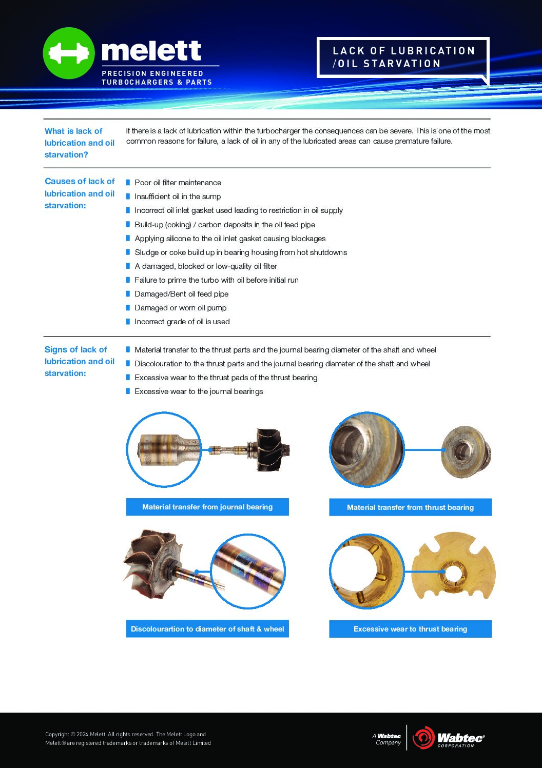Common turbo failure – foreign object damage
What is foreign object damage?
A foreign object is simply any object that enters the turbocharger through the air inlet or exhaust inlet. When a foreign object enters the turbocharger, its performance will be affected. There are various reasons for this damage, as well as signs to look out for and ways to prevent it.
View our latest Melett Turbo Tips video – How does foreign object damage (FOD) cause turbocharger failure?

Today we will be discussing the causes, signs and preventions associated with Foreign Object Damage.
What is Foreign Object Damage? A foreign object enters the turbocharger through either the air intake or exhaust manifold, if this makes contact with either
the Compress Wheel or Shaft & Wheel this will impact the performance of the turbocharger.
Foreign objects can be anything from carbon particles to water. Let’s discuss the causes of Foreign Object Damage.
Exhaust gases containing particles such as coke or material fragments from a damaged engine.
Missing, damaged or low-quality air filter.
Any small particles entering though slips in the hose or rags and washes ?? that have been left there.
Exhaust gases containing particles
Missing/damaged air filter
Particles entering through damaged hoses
Items left in the intake pipe
We have discussed the causes, let’s now have a look at some of the signs of Foreign Object Damage.
The main signs of Foreign Object Damage will be noise or performance-related and you will not be able to see the damaged caused until you have taken the turbo
off the vehicle or stripped down the turbocharger.
Compressor Wheel, Shaft and Wheel and VNT will show signs of Foreign Object Damage.
Two examples of Compressor Wheels here, one with mild damage and one with extreme damage. Pitting marks caused by Foreign Object Damage is visible on the
Inducer blades.
Turbine end of the Turbocharger contains the Shaft and Wheel and the VNT, these will show signs of Foreign Object Damage.
On the VNT blades, pitting marks will be visible.
Shaft and Wheel will show damage to the inducer side of the blade, where the Foreign Object/s has entered the turbine housing.
We have a supporting PDF available on the Melett website.
Now, lets’ discuss how we can prevent Foreign Object Damage occurring to your turbocharger.
Check the air hoses are intact, in good working condition and free from blockages.
Check the air filter and always use new gaskets if possible.
If there has been a turbocharger failure or engine failure, please check the entire exhaust system is free from all fragments.
Check the air hoses are intact
Check the air filter and where possible use new gaskets
Check that the exhaust system is free from all fragments
Melett Turbo Tip – Do not assume the damage to be minor, unless you replace this turbocharger, it will continue to deteriorate and fail.
We hope you have enjoyed this series of videos surrounding failure modes. Keep a lookout for future videos from Melett and thank you for watching.
Enjoyed our Video? Press the like button, leave us a comment below or subscribe to our YouTube Channel to watch further videos from Melett.
Causes of foreign object damage
- Small particles entering through a damaged hoses connected to the turbocharger.
- Objects sucked into the air intake through damaged (or faulty), of a low quality, or missing air filter.
- Debris from a previous turbocharger failure can stay in the systems and damage the new one
- Broken off engine components, e.g. valves, fragments of damaged pistons or injector tips.
- Objects left in the intake pipe during servicing like bolts, nuts, washers, rags or other items.
- Particles in the exhaust gases e.g. coke from poor combustion.
- Ice in low temperature conditions which can form within the intake system.
Signs of foreign object damage:
- Noise from the turbo during operation such as grinding, rattling, or high-pitched sounds.
- Loss of performance and power output from the engine.
- Visible damage to the compressor or turbine blades.
- Pitting around the compressor inlet.
- Pitting on the nozzle ring assembly vanes.

Preventing turbo failure caused by foreign object damage:
- Ensure air hoses are free from blockages, regularly check them for any signs of damage, cracks, or leaks.
- Remove any loose objects or debris that may accumulate during servicing.
- Check the air hoses’ integrity, ensuring they are intact and properly connected to prevent objects from entering the turbocharger.
- Always use the correct air filter suitable for your specific vehicle model and regularly replace it according to the manufacturer’s recommendation.
- Clean the intake and exhaust system after a turbocharger failure to eliminate any debris or fragments that could harm the new turbocharger.
- Using new gaskets helps to prevent the possibility of gasket break up and ensure a perfect seal.
- Avoid running the vehicle without the air intake connected to the turbocharger to prevent objects from getting sucked in.
Please note: Never continue to operate a turbocharger with damaged blades as the rotor balance will be affected and this could impact its service life.
For further information on this or other topics, please contact Melett Technical Support – [email protected].



